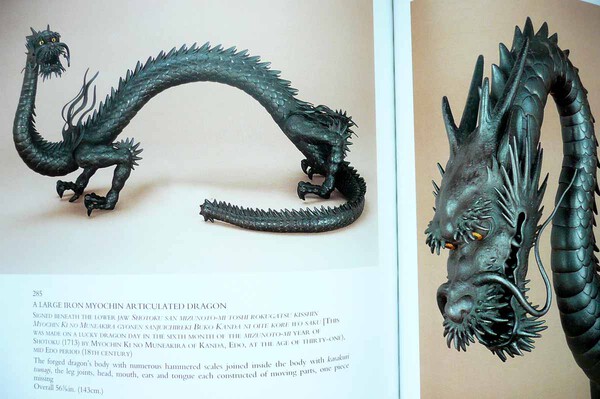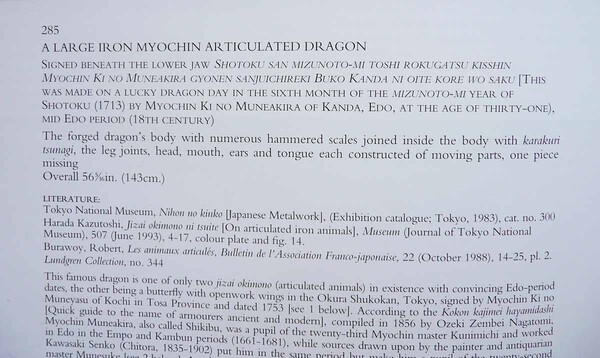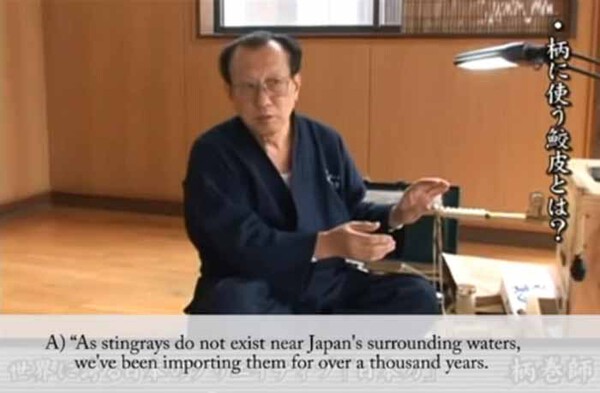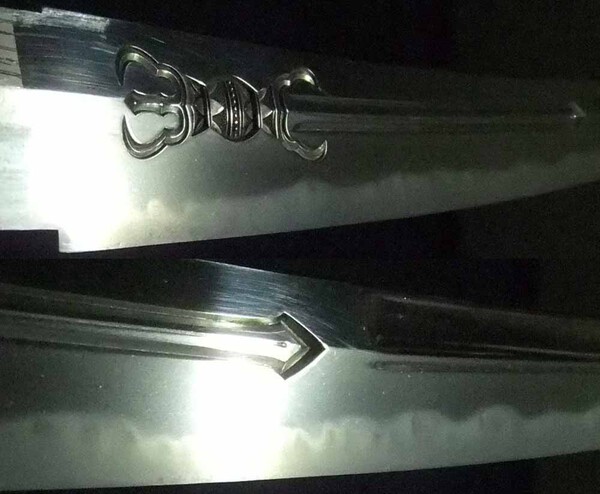-
Posts
1,029 -
Joined
-
Last visited
Everything posted by Eric H
-
The Lundgren Collection sale at Christie‘s London 1997 Nov 18 had a Dragon by Myochin Ki no Muneakira, 143 cm, Lot 285, and also an articulated Snake, 125 cm, Lot 279, by Myochin Muneyoshi, both in perfect condition. Estimate Dragon: £ 50‘000/70‘000 - $ 81,000/110,000 unsold Estimate Snake: £ 8‘000/10‘000 - $ 13,000/16,000 unsold The Lundgren Dragon is by now the largest known Dragon Eric
-

Has anyone heard of this before???
Eric H replied to Nickupero's topic in General Nihonto Related Discussion
-
The photographer has made an excellent job. The horimono is on a tachi by Shirokuma-nyudo Masahide dated Bunsei 4 (1821). The quality of this elaborately carved horimono suggests to be the work of Honjo Yoshitane. Eric
-

Has anyone heard of this before???
Eric H replied to Nickupero's topic in General Nihonto Related Discussion
scientific name of the stingray is: dasyatidae Eric -
The best way to appreciate and evaluate the quality of a horimono is when holding the blade in hand. A horimono is 3-dimensional and it is difficult to make accurate photos because of the light/shadow effect. I add some pics, please have a look at the ken tip, which is magnified and displays the accuracy of the angles. This horimono is on a shinshinto tachi and obviously cut by one of the three great horimono-shi of the Bakumatsu period (there is no hori-dosaku) It‘s an example for kantei. Eric
-
What has been said on the inferior quality of the horimono, despite of its polished state, is correct. horimono on a tanto by Soshu Tsunahiro Eric
-
Conclusion, what YOU haven‘t seen doesn‘t exist. Andreas you are right its exactly this tanto. I have recently read in a political analysis that foolishness is a raw material that grows again. I‘m very thin-skinned when someone calls me to be a liar. Eric
-
Why wait and waste time until October? If you are so eager to prove your statement please post the picture immediately to Aoi. I am myself very interested in Tsuruta san‘s reply. I suppose the picture was not made by Tsuruta san personally but by one of his employees. Eric
-
tz-tz-tz...you are always good for a surprise ... the posted pic was intended to show his skill in carving as well the seldom seeing of a horimono on a nakago. The Genji ninen tanto with koshirae was available at Aoi for US$ 15,000.00 in October 2011. I don‘t like to start a fruitless discussion on the authenticity of the mei. My advice to you, based on my own experience, is: post the image to Aoi, you will get an answer from Tsuruta san...he offers this service free of charge. Eric
-
Nidai Masahide left few swords in his life. I have another example in my library where he signed with „Kawabe Sadahide“. More detailed information can be found in Markus‘ index, however there is no mention that he has signed with the name „Amahide“. The following pics are from a Katana by nidai Masahide. In the third year of Bunsei (1820) he entered priesthood and took the „go“ „Hakuyu“ which can also be read as „Shirokuma“. The omote mei is explained and the interested reader will notice that the nenki on the nakago is ...nigatsu and not sangatsu. Eric
-
Aoi website...and yes they are all NBTHK Hozon and higher. Well, the few pictures I have posted show how difficult it is to reveal the authenticity of his mei based solely on „Gassan and Sadakazu“. Generally his mei is carefully executed as can be expected for he was one of the great horimono carvers of the Bakumatsu period, beside Yoshitane and Nobuhide. Eric
-
which traits to be concise? For instance the kanji Gassan and Sadakazu...these kanji should be closely examined. The differences in the course of his career are obvious and well presented in the comparison above. I add some other pics from his early stage, namely from end Shinshinto and start Genji. The quality of his chiseling is also inconsistent. Last pic shows a shoshin and a gimei oshigata. Eric
-
-
At first glance the mei looks to be shoshin. Eric
-
Definitely No... why should a highly respected swordsmith risk his reputation? A member of NMB had once a O-Kogatana by So Tsutomu for sale. Eric Aoi Appraisal Quiz: 212 + 245
-
Sword Stand for Daisho When a sword is placed on its rack, the sageo should be wound neatly round the scabbard at the kurikata. The colouring of the sageo corresponds to that of the scabbard to which it is attached; if the latter is in good Japanese taste, quiet and sober, the sageo will be similar, but gaudy and variegated braid is often found on a flashily mounted weapon. The sword rack should, if possible, contrast in colour and decoration with the sword placed upon it. Eric
-
-

Tampa 2014 report
Eric H replied to Grey Doffin's topic in Sword Shows, Events, Community News and Legislation Issues
Chris, thanks for explaining the background of what has happened. This relativises some other harsh opinions. Criticism is easily given and it‘s questionable if collectors have enough knowledge to evaluate the work of a togishi with maybe 40 years experience. I suppose he knew the importance of the sword and made the appropriate polish. However the enthusiasm of the shinsa team, the experts, says it all. Eric -

Tampa 2014 report
Eric H replied to Grey Doffin's topic in Sword Shows, Events, Community News and Legislation Issues
The main topic of this Tampa report is the resurrection of the Akihiro Wakizashi. Was it there for exposition only or for sale?...and a lot of speculations and explanations on the why and for which reason the outcome of its failed polish...and the claim after the togishi‘s identity. Basically a self-respecting togishi would never deliver a frouzy polish even under „special“ circumstances as said. Confiscation...if at all could it be confiscated in agreement with Japanese laws? The most interesting question is who knew that it is the true Akihiro bijutsuhin.... by logic it‘s the owner who sent it in reportedly bad condition to the polisher in Japan and hastily ordered it back. Robert: I have handled over 20 blades polished by him and his usual standard is high. He underwent a 10 year apprenticeship with a mukansa polisher. Arnold F.: I have seen nice work by the polisher.... Both know who the polisher is and testify the quality of his works. As said, obscure circumstances together with bad condition of the blade have resulted in a crappy polish. But the polisher should have the opportunity to explain the story. If I‘m not wrong it‘s the togishi who learned under the tutelage of Sensei Naoji Karita in Tokyo. Eric -
Thanks for posting the two links :D Eric
-
Yes Shinshinto Tegarayama Masashige Eric
-

How Important is Provenance?
Eric H replied to Loco Al's topic in General Nihonto Related Discussion
-

How Important is Provenance?
Eric H replied to Loco Al's topic in General Nihonto Related Discussion
Well, such stories should always be viewed with extreme caution. The daisho of course has a „story“ but it lacks the level of highgrade art-swords together with a direct connection to a important historic person or family. There is a Go Yoshihiro, nicknamed Nabeshima Go, who answers all expectations as to art-sword and provenance. A dream package. Eric -

How Important is Provenance?
Eric H replied to Loco Al's topic in General Nihonto Related Discussion
It is a misunderstanding to believe somebody collects Nihonto focussed on „provenance“ only. What kind of provenance...a rusted Katana from the battlefield of Sekigahara? No, provenance or background -proven- attached to an individual sword is what increases its value, and the closer linking to a historic person or family is, the higher the agio is. As people should know there are objets d‘art priceless because they are once used by very famous Individuals in Japan‘s History. (Go and buy a chawan used by Sen no Rikyu). This is what I‘m talking about: Miyamoto Musashi and his last sword by Ryokai, JuTo, 85.4 cm Eric
























